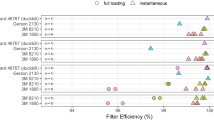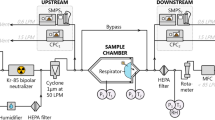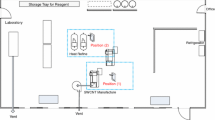Abstract
Nanoparticle (particles with diameter ≤100 nm) exposure is recognized as a potentially harmful size fraction for pulmonary particle exposure. During nanoparticle synthesis, the number concentrations in the process room may exceed 10 × 106 cm−3. During such conditions, it is essential that the occupants in the room wear highly reliable high-performance respirators to prevent inhalation exposure. Here we have studied the in-use program protection factor (PPF) of loose-fitting powered air purifying respirators, while workers were coating components with TiO2 or Cu x O y nanoparticles under a hood using a liquid flame spray process. The PPF was measured using condensation particle counters, an electrical low pressure impactor, and diffusion chargers. The room particle concentrations varied from 4 × 106 to 40 × 106 cm−3, and the count median aerodynamic diameter ranged from 32 to 180 nm. Concentrations inside the respirator varied from 0.7 to 7.2 cm−3. However, on average, tidal breathing was assumed to increase the respirator concentration by 2.3 cm−3. The derived PPF exceeded 1.1 × 106, which is more than 40 × 103 times the respirator assigned protection factor. We were unable to measure clear differences in the PPF of respirators with old and new filters, among two male and one female user, or assess most penetrating particle size. This study shows that the loose-fitting powered air purifying respirator provides very efficient protection against nanoparticle inhalation exposure if used properly.




Similar content being viewed by others
References
AIHA (2002) Respiratory protection committee: respirator performance terminology. Letter to the Editor. Am Ind Hyg Assoc J 63:132
Bergman MS, Viscusi DJ, Zhuang Z, Palmiero AJ, Powell JB, Shaffer RE (2012) Impact of multiple consecutive donnings on filtering facepiece respirator fit. Am J Infect Control 40:375–380
Borm PJA, Robbins D, Haubold S et al (2006) The potential risks of nanomaterials: a review carried out for ECETOC. Part Fibre Toxicol 3:11. doi:10.1186/1743-8977-3-11
Brochot C, Michielsen N, Chazelet S, Thomas D (2012) Measurement of protection factor of respiratory protective devices toward nanoparticles. Ann Occup Hyg 56:595–605
Chen CC, Willeke K (1992) Characteristics of face seal leakage in filtering facepieces. Am Ind Hyg Assoc J 53:533–539
Chen S-C, Wang J, Bahk YK, Fissan H, Pui DYH (2014) Carbon nanotube penetration through fiberglass and electret respirator filter and nuclepore filter media: experiments and models. Aerosol Sci Tech 48:997–1008
Cheng YS (2001) Condensation detection and diffusion size separation techniques. In: Baron PA, Willeke K (eds) Aerosol measurements: principles, techniques and applications. Wiley-Interscience, New York, pp 569–601
Cho KJ, Reponen T, McKay R, Dwivedi A, Adhikari A, Singh U, Shukla R, Junes S, Jones G, Grinshpun SA (2011) Comparison of workplace protection factors for different biological contaminants. J Occup Environ Hyg 8:417–425
Clayton MP, Bancroft B, Rajan B (2002) A Review of assigned protection factors of various types and classes of respiratory protective equipment with reference to their measured breathing resistances. Ann Occup Hyg 46:537–547
Code of Federal Regulations (2006) Title 29 (6), Respiratory Protection, Section 1910.134. pp 419–444
Cohen HJ, Hecker LH, Mattheis DK et al (2001) Simulated workplace protection factor study of powered air-purifying and supplied air respirators. Am Ind Hyg Assoc 62:595–604
ECETOC (2004) ECETOC targeted risk assessment. Technical Report No. 93, European Centre for Ecotoxicology and Toxicology of Chemicals, Belgium
Elsaesser A, Howard CV (2012) Toxicology of nanoparticles. Adv Drug Deliv Rev 64:129–137
Fransman W, Van Tongeren M, Cherrie JW, Tischer M, Schneider T, Schinkel J, Kromhout H, Warren N, Goede H, Tielemans E (2011) Advanced reach tool (ART): development of the mechanistic model. Ann Occup Hyg 55:957–979
Givehchi R, Tan Z (2014) An overview of airborne nanoparticle filtration and thermal rebound theory. Aerosol Air Qual Res 14:45–63
Harrison B, Liang S (2005) Quantitative fit testing of military gas masks with the TSI Portacount. Part II: quantifying the limitations and recommendations for use. JISRP 22:55–67
Hinds WC, Kraske G (1987a) Performance of dust respirators with facial seal leaks I. Experimental. Am Ind Hyg Assoc J 48:836–841
Hinds WC, Kraske G (1987b) Performance of dust respirators with facial seal leaks II. Predictive model. Am Ind Hyg Assoc J 48:842–847
Holmgern H, Ljungström E, Almstrand A-C, Bake B, Olin A-C (2010) Size distribution of exhaled particles in the range from 0.01 to 2.0 mm. J Aerosol Sci 41:439–446
Huang S-H, Chen C-W, Kuo Y-M, Lai C-Y, McKay R, Chen C-C (2013) Factors affecting filter penetration and quality factor of particulate respirators. Aerosol Air Qual Res 13:162–171
ISO (2008) Nanotechnologies—terminology and definitions for nanoobjects—nanoparticle, nanofibre and nanoplate. International Organization for Standardization. ISO TS 27687
Janssen LL, Nelson TJ, Cuta KT (2007) Workplace protection factors for an N95 filtering facepiece respirator. J Occup Environ Hyg 4:698–707
Janssen L, Bidwell J, Cuta K, Nelson T (2008) Workplace performance of a hood-style supplied-air respirator. J Occup Environ Hyg 5:438–443
Janssen L, Zhuang Z, Shaffer R (2014) Criteria for the collection of useful respirator performance data in the workplace. J Occup Environ Hyg 11:218–226
Joe YH, Yoon KY, Hwang J (2014) Methodology for modeling the microbial contamination of air filters. PLoS ONE 9:e88514. doi:10.1371/journal.pone.0088514
Johnston AR, Myers WR, Colton CE, Birkner JS, Campbell CE (1992) Review of respirator performance testing in the workplace: issues and concerns. Am Ind Hyg Assoc J 53:705–712
Koivisto AJ, Aromaa M, Mäkelä JM, Pasanen P, Hussein T, Hämeri K (2012) Concept to estimate regional inhalation dose of industrially synthesized nanoparticles. ACS Nano 6:1195–1203
Koivisto AJ, Palomäki JE, Viitanen A-K, Siivola KM, Koponen IK, Yu M, Kanerva TS, Norppa H, Alenius HT, Hussein T, Savolainen KM, Hämeri KJ (2014) Range-finding risk assessment of inhalation exposure to nanodiamonds in a laboratory environment. Int J Environ Res Public Health 11(5):5382–5402
Levin M, Koponen IKK, Jensen KA (2014) Exposure assessment of four pharmaceutical powders based on dustiness and evaluation of damaged HEPA filters. J Occup Environ Hyg 11:165–177
Li L, Zuo Z, Japuntich DA, Pui DYH (2012) Evaluation of filter media for particle number, surface area and mass penetrations. Ann Occup Hyg 56:581–594
Lim SS, Vos T, Flaxman AD et al (2012) A comparative risk assessment of burden of disease and injury attributable to 67 risk factors and risk factor clusters in 21 regions, 1990–2010: a systematic analysis for the Global Burden of Disease Study 2010. Lancet 380:2224–2260
Liu BYH, Lee JK (1993) Respirator leak detection by ultrafine aerosols: a predictive model and experimental study. Aerosol Sci Technol 19:15–26
Mäkelä JM, Keskinen H, Forsblom T, Keskinen J (2004) Generation of metal and metal oxide nanoparticles by liquid flame spray process. J Mater Sci 39:2783–2788
Mäkelä JM, Aromaa M, Rostedt A, Krinke TJ, Janka K, Marjamäki M, Keskinen J (2009) Liquid flame spray for generating metal and metal oxide nanoparticle test aerosol. Hum Exp Toxicol 28:421–431
Marquart H, Heussen H, Le Feber M, Noy D, Tielemans E, Schinkel J, West J, Van Der Schaaf D (2008) ‘Stoffenmanager’, a web-based control banding tool using an exposure process model. Ann Occup Hyg 52:429–441
Meng X, Ma Y, Chen R, Zhou Z, Chen B, Kan H (2013) Size-fractionated particle number concentrations and daily mortality in a Chinese city. Environ Health Perspect 121:1174–1178. doi:10.1289/ehp.1206398
OSHA US Department of Labor (2009) Assigned protection factors for the revised respiratory protection standard. OSHA 3352-02
Pekkanen J, Timonen KL, Ruuskanen J, Reponen A, Mirme A (1997) Effects of ultrafine and fine particles in urban air on peak flow respiratory flow among children with asthmatic symptoms. Environ Res 74:24–33
Peters A, Wichmann HE, Tuch T, Heinrich J, Heyder J (1997) Respiratory effects are associated with the number of ultrafine particles. Am J Respir Crit Care Med 155:1376–1383
Rengasamy S, Eimer BC (2011) Total inward leakage of nanoparticles through filtering facepiece respirators. Ann Occup Hyg 55:253–263
Rengasamy S, BerryAnn R, Szalajda J (2013) Nanoparticle filtration performance of filtering facepiece respirators and canister/cartridge filters. J Occup Environ Hyg 10:519–525
Reponen T, Lee S-A, Grinshpun A, Johnson E, McKay R (2011) Effect of fit testing on the protection offered by N95 filtering facepiece respirators against fine particles in a laboratory setting. Ann Occup Hyg 55:264–271
Savolainen K, Pylkkänen L, Norppa H, Falck G, Lindberg H, Tuomi T, Vippola M, Alenius H, Hämeri K, Koivisto J, Brouwer D, Mark D, Bard D, Berges M, Jankowska E, Posniak M, Farmer P, Singh R, Krombach F, Bihari P, Kasper G, Seipenbusch M (2010) Nanotechnologies, engineered nanomaterials and occupational health and safety—a review. Saf Sci 48:957–963
Shaffer RE, Rengasamy S (2009) Respiratory protection against airborne nanoparticles: a review. J Nanopart Res 11:1661–1672
Shin W, Pui DYH, Fissan H, Neumann S, Trampe A (2007) Calibration and numerical simulation of nanoparticle surface area monitor (TSI model 3550 NSAM). J Nanopart Res 9:61–69
Strak M, Janssen NAH, Godri KJ, Gosens I, Mudway IS, Cassee FR, Lebret E, Kelly FJ, Harrison RM, Brunekreef B, Steenhof M, Hoek G (2012) Respiratory health effects of airborne particulate matter: the role of particle size, composition, and oxidative potential—the RAPTES project. Environ Health Perspect 120:1183–1189
Tielemans E, Warren N, Fransman W, Van Tongeren M, McNally K, Tischer M, Ritchie P, Kromhout H, Schinkel J, Schneider T, Cherrie JW (2011) Advanced REACH Tool (ART): overview of version 1.0 and research needs. Ann Occup Hyg 55:949–956
Tikkanen J, Gross KA, Berndt CC, Pitkänen V, Keskinen J, Raghu S, Rajala M, Karthikeyan J (1997) Characteristics of the liquid flame spray process. Surf Coat Technol 90:210–216
Tischer M, Bredendiek-Kämper S, Poppek U, Packroff R (2009) How safe is control banding? Integrated evaluation by comparing OELs with measurement data and using Monte Carlo simulation. Ann Occup Hyg 53:449–462
Vaughan NP, Tierney AM, Brown RC (1994) Penetration of 1.5–9.0 μm diameter monodisperse particles through leaks into respirators. Ann Occup Hyg 38:879–893
Vo E, Zhuang Z (2013) Development of a new test system to determine penetration of multi-walled carbon nanotubes through filtering facepiece respirators. J Aerosol Sci 61:50–59
Vo E, Zhuang Z, Birch E, Zhao Q, Horvatin M, Liu Y (2014) Measurement of mass-based carbon nanotube penetration through filtering facepiece respirator filtering media. Ann Occup Hyg 58:646–656
Wang J, Kim SC, Pui DYH (2011) Measurement of multi-wall carbon nanotube penetration through a screen filter and single-fiber analysis. J Nanopart Res 13:4565–4573
Yokel RA, MacPhail RC (2011) Engineered nanomaterials: exposures, hazards, and risk prevention. J Occup Med Toxicol. doi:10.1186/1745-6673-6-7
Acknowledgments
This work was made in close collaboration with Ms. Elina Miettinen and Mr. Janne Haapanen at Aerosol Physics Laboratory, and Mr. Tomi Kanerva at Department of Material Sciences, Tampere University of Technology.
Funding
The research leading to these results has received funding from the European Union Seventh Framework Programme [FP7/2007-2013] under EC-GA No. 604305 ‘SUN’.
Author information
Authors and Affiliations
Corresponding author
Rights and permissions
About this article
Cite this article
Koivisto, A.J., Aromaa, M., Koponen, I.K. et al. Workplace performance of a loose-fitting powered air purifying respirator during nanoparticle synthesis. J Nanopart Res 17, 177 (2015). https://doi.org/10.1007/s11051-015-2990-9
Received:
Accepted:
Published:
DOI: https://doi.org/10.1007/s11051-015-2990-9




